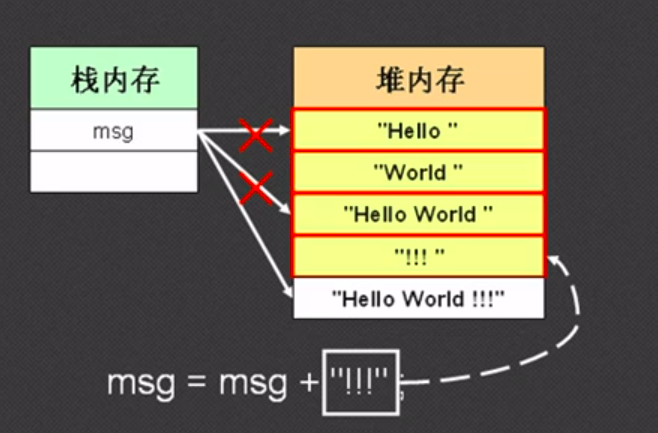一、String常用的方法:

1. == 实质比较两个对象的地址数值
String a = "hello" (hello为匿名对象)
String a1 = "hello"
String b = new String("hello")
String b1 = new String("hello").intern
String c = b;
a == b ----------> false false的原因:new会为b新开辟一块内存,所以比较时候两个地址不同(String里面含有intern方法)
可以手动向字符串池中添加,运行结果就是ture)
a == a1 --------> ture ture的原因:第一次字符串常量会放入“字符串池”中,下次再次申请时候,会指向同一块的内存
如果不存在的话,会自动加入内存池中
b == c --------->true
注意:开发时候大部分使用String a1 = "hello"此类方法,避免new String对象会开辟新的内存,造成内存的的浪费。
即使new出新的对象,使用intern()方法也会把字符串加入字符串池中
2.equals : 字符串比较里面的内容
b.equals(a)
hello.equals(a)
如果String b = null 时候,系统会抛出nullPointExction(空指针异常),开发时候大部分都使用hello.equals(a)此类方法,
原因:就是可以避免出现字符串为空时候抛出的异常
3.开发过程中尽量不要大规模使用String + "hello" + "world"............ , 因为这样也会造成内存的浪费

4.String常用的函数名
(1). char charAt(int index) : 查找制定索引的字,第几个位置是什么字母就输出什么字母
(2). boolean equals(String s) : 比较两个字符的内容是否相同
(3). boolean equalsIgnoreCase(String s) : 比较两个字符串是否相同,忽略大小写
(4). int compareTo(String s) : 比较两个字符串的大小关系
(5). boolean contains(String s) : 查找字符串是否存在
(6). int indexOf(String s) : 从起始位置开始查找字符串,存在返回索引数值,不存在返回-1
(7). int indexOf(String s , int fromIndex ) : 从fromIndex位置开始查找,存在返回索引数值,不存在返回-1
(8). boolean startWith(String s) : 判断是否以指定字符串作为起始位置
(9). boolean startWith(String s , int fromIndex) : 判断是否已指定字符串从fromIndex位置作为起始位置
(10). endWith(String s) : 判断是否已指定字符作为结束位置
(11). String replaceAll(String s , String replace) : 把字符串s全部替换成replace字符串
(12). String replaceFrist(String s , String replace) : 字符串replace只替换第一个s字符串,其余的s字符串的都不用替换
(13). String[] split(String s) : 把字符串s全部拆分成字符串数组 String data[] = String.split(" ") : 这个是按空格来拆分的
(14). String split(String s , int limit) : 将字符串s部分拆分成字符串数组个数limit的长度
(15). String substring(int beginIndex) : 从beginIndex位置截取到字符串结尾
(16). String substring(int beginIndex , int endIndex) : 从beginIndex位置截取到字符串endIndex结束
(17). String intern() : 把字符串对象加入字符串池中
(18). boolean isEmpty() : 判断字符串是否为空
(19). int length() : 获得字符串的长度
(20). String trim() : 去掉字符串的左右空格
(21). String concat(String s) : 字符串连接
(22). String toUpperCase() : 将字符串小字母转化成大写字母
(23). String toLowerCase() : 将字符串大写字母转成小写字母
5.字符串转为基本数据
public static int parseInt(String s)
public static double parseInt(String s)
public static boolean parseInt(String s)
6.基本数据类型转换成字符串
public static String valueOf(int 、double、boolean)
二、集合学习


